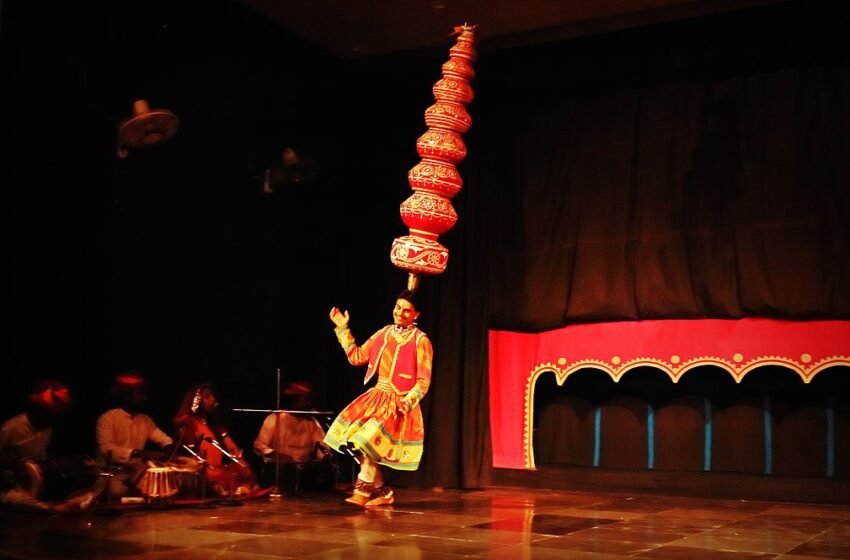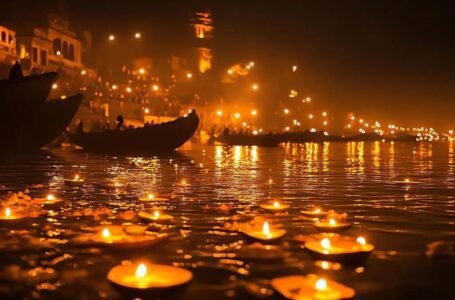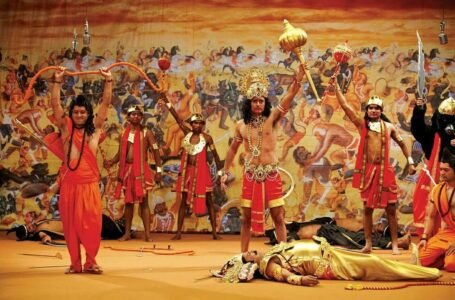Bhavai: The Daring Folk Dance of Rajasthan and Gujarat

Bhavai is one of the most thrilling and visually mesmerizing folk dances of India, performed primarily in the states of Rajasthan and Gujarat. This dance form is a perfect blend of artistry, skill, and cultural expression, featuring female performers balancing multiple earthen pots or brass pitchers on their heads while gracefully dancing on glass, the edge of a sword, or a brass plate.
More than just a dance, Bhavai is a testament to the strength, endurance, and traditions of the women of Rajasthan and Gujarat. The performance is marked by extraordinary balancing skills, vibrant Rajasthani attire, traditional folk music, and a breathtaking display of acrobatics. Though originally a community-based performance, Bhavai has evolved into a spectacle for tourists and cultural festivals today.
This article explores the origins, historical significance, performance style, attire, musical elements, and the modern-day challenges of this disappearing art form.
Origins and Historical Background
The exact origins of Bhavai remain debated, but scholars believe that it has roots in both Rajasthan and Gujarat. Some historical accounts suggest that Bhavai evolved from the everyday balancing skills of Rajasthani and Gujarati women, who would travel long distances carrying multiple pots of water on their heads. Over time, this necessity transformed into an art form, with women adding elements of dance and acrobatics to showcase their skills.
Another perspective links Bhavai to tribal communities, particularly the Bhil, Jat, Raigar, Meena, Kumhar, and Kalbelia tribes of Rajasthan. These communities, known for their resilience and cultural heritage, are believed to have refined Bhavai into an elaborate performance with musical accompaniments.
The earliest known Bhavai dancer was Krishna Vyas Chhangani, born in Jodhpur, Rajasthan. She popularized the dance and set a benchmark for future performers.
While Rajasthan is more famous for Bhavai, Gujarat also claims a version of this tradition, which evolved alongside the Bhavai folk theatre performed by male actors in colorful attire and masks. This theatre form is distinct from Bhavai dance but shares some cultural similarities.
Performance and Unique Elements
Bhavai is not just a dance but an extreme test of balance, grace, and courage. The female performer, often veiled, balances 7 to 22 brass, metal, or earthen pots on her head while executing intricate dance moves. Some performances even involve lighting fire on top of the stacked pots, adding an element of danger.
The Most Thrilling Elements of Bhavai Dance:
- Balancing on Sharp Objects:
Dancers stand on the edge of a sword, the rim of a brass plate (thali), or even broken glass while maintaining perfect posture and movement.
- Pirouettes and Swaying Movements:
Despite the weight of the pots, performers execute spins, sways, and rhythmic footwork without disturbing the stack.
- The Climax – A Daring Display:
The performance typically ends with the dancer balancing herself on sharp weapons or a brass plate, marking the grand climax of the dance.
These elements create a nail-biting spectacle, leaving the audience in awe of the dancer’s poise and control.
Music and Instruments
Bhavai performances are incomplete without the soul-stirring melodies of Rajasthani folk music. Male musicians provide the rhythmic and melodic backdrop, using traditional instruments such as:
Pakhawaj – A barrel-shaped drum providing deep beats.
Dholak – A two-headed drum played with hands.
Jhanjhar – Metallic cymbals that add a ringing sound.
Sarangi – A bowed string instrument producing emotional tunes.
Harmonium – A keyboard instrument that complements the vocals.
Accompanying the music are folk songs, often narrating heroic tales, devotional hymns, or stories of village life. These songs, combined with the movements of the dancer, make Bhavai a captivating storytelling experience.
Attire and Ornaments
Bhavai dancers wear traditional Rajasthani and Gujarati attire, which enhances the visual appeal of the performance.
Women’s Costume:
Ghagra-Choli: A colorful, embroidered skirt and blouse adorned with mirror work and gota patti.
Dupatta: A long, flowing veil draped over the head, sometimes covering the face.
Ornaments: Heavy silver jewelry, bangles, anklets, armlets, and traditional Rajasthani nose rings.
Men’s Attire:
Dhoti-Kurta: White or off-white, paired with a vibrant sleeveless jacket.
Kamarbandh: A cloth belt around the waist, adding a royal touch.
Turban: A colorful Rajasthani headdress, often adorned with mirror work.
While men do not perform the dance, their presence as musicians is crucial to maintaining the tempo and energy of the performance.
Cultural and Social Significance
Bhavai is deeply connected to Rajasthani culture and heritage, symbolizing:
- The Strength of Women:
The dance is a tribute to the resilience and endurance of Rajasthani women who walk miles carrying water pots.
- Community Celebrations:
It is performed during weddings, festivals, and grand occasions, making it a vital part of Rajasthani social life.
- A Symbol of Rajasthan’s Rich Traditions:
Just like Ghoomar and Kalbelia, Bhavai represents the color, courage, and spirit of Rajasthan.
Modern-Day Challenges and Survival
Despite its historical and cultural significance, Bhavai faces several challenges today:
- Shift to Tourism and Commercialization:
Bhavai is now performed mainly for tourists in hotels and cultural festivals, losing its original community-based essence.
- Declining Traditional Knowledge:
Younger generations are less interested in learning Bhavai due to modern influences and the decline of traditional performance spaces.
- Safety Concerns:
The dangerous balancing acts have led to safety regulations, reducing the number of expert dancers willing to perform at an advanced level.
- Competition from Other Art Forms:
With the rise of Bollywood and contemporary dance, folk traditions like Bhavai struggle for attention.
However, efforts are being made to preserve Bhavai:
Organizations like Bhawai Lok Kala Sansthan are working to keep the dance form alive.
Cultural festivals and government initiatives aim to promote and support folk artists.
Some dancers and musicians continue to train the next generation, ensuring that Bhavai remains a living tradition.
Conclusion
Bhavai is more than just a folk dance—it is a cultural legacy, a display of grace under pressure, and a testament to the strength and artistry of Rajasthani and Gujarati women.
While modernization poses challenges, the essence of Bhavai still thrives in heritage festivals, performances for tourists, and dedicated preservation efforts. Watching a Bhavai dancer balance multiple pots while moving effortlessly across swords and glass is not just entertainment—it is witnessing the heartbeat of Rajasthan’s timeless folk traditions.
As long as efforts continue to support folk artists and cultural preservation, Bhavai will remain an iconic representation of India’s rich artistic heritage.


